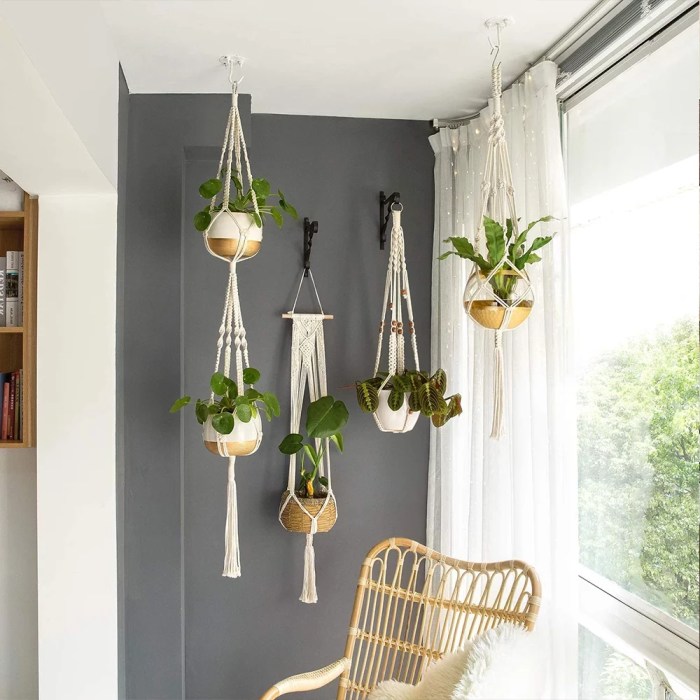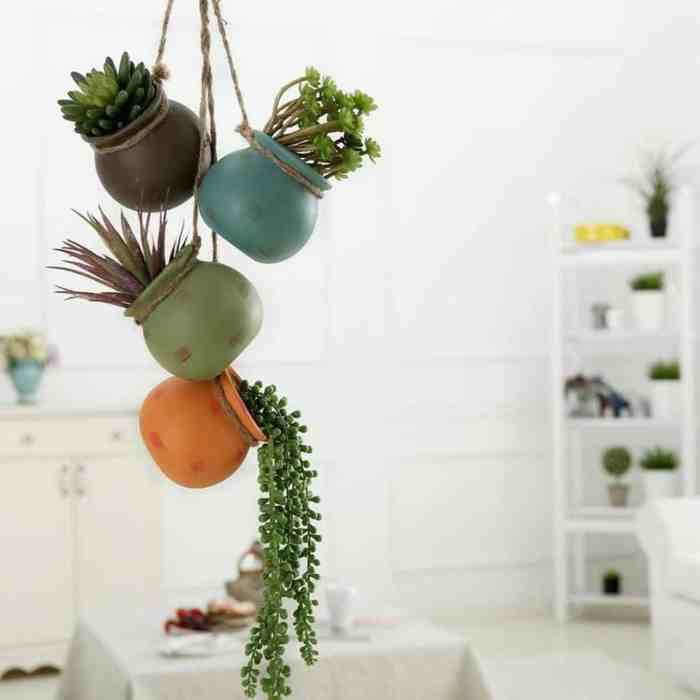Best pots for hanging plants indoor – In the realm of interior design, hanging plants have emerged as a captivating element, adding a touch of greenery and vibrancy to any space. However, selecting the right pots for these suspended botanical wonders is crucial to ensure their health and aesthetic appeal.
This comprehensive guide delves into the world of best pots for hanging plants indoors, exploring their styles, materials, drainage considerations, plant compatibility, and maintenance tips.
Hanging Plant Aesthetics and Material Considerations

Hanging plants bring a touch of greenery and elegance to indoor spaces. The choice of hanging pot plays a significant role in enhancing the visual appeal of these plants and complementing the overall décor.
Hanging pots come in a wide range of styles and designs, from classic to contemporary. Consider the shape, size, and color of the pot to match the plant’s growth habit and the surrounding décor. Ceramic pots offer a timeless look, while metal pots provide a modern touch.
Plastic pots are lightweight and durable, while macrame hangers add a bohemian flair.
Materials for Hanging Pots
- Ceramic:Durable, heavy, and available in various colors and glazes.
- Metal:Lightweight, rust-resistant, and comes in different finishes such as copper, brass, and black.
- Plastic:Affordable, lightweight, and easy to clean.
- Macrame:Woven cords made of cotton or jute, adding a natural and textured look.
The choice of material depends on factors such as the plant’s weight, the desired aesthetic, and the durability required. For heavier plants, ceramic or metal pots provide better stability. For lightweight plants, plastic or macrame hangers are suitable.
Popular Hanging Pot Designs
- Hanging baskets:Open-weave baskets that allow for ample drainage and aeration.
- Macrame hangers:Intricate knots and patterns create a unique and bohemian look.
- Wall-mounted planters:Vertical planters that save space and add a modern touch.
- Geometric planters:Angular and geometric shapes add a contemporary aesthetic.
- Woven baskets:Natural fibers such as wicker or seagrass provide a warm and earthy look.
By considering the plant’s needs, the desired aesthetic, and the available materials, one can choose the perfect hanging pot to showcase indoor plants and create a captivating indoor oasis.
Drainage and Watering Considerations
Proper drainage is essential for indoor hanging plants as it prevents waterlogging, which can lead to root rot and other issues. Choose pots with multiple drainage holes at the bottom to allow excess water to escape.
Watering Methods
There are several methods for watering hanging plants:
-
-*Top-watering
Water the plant from above, allowing the water to flow through the soil and out the drainage holes. This is the most common method.
-*Bottom-watering
Place the hanging pot in a shallow dish filled with water. The plant will absorb water from the bottom, through the drainage holes. This method is less likely to cause waterlogging.
-*Self-watering systems
These systems use a reservoir to automatically water the plant. They can be helpful for plants that require consistent moisture levels.
Watering Tips
- Water hanging plants thoroughly, but allow the excess water to drain away.
- The frequency of watering will vary depending on the type of pot, plant species, and environmental conditions.
- Monitor the soil moisture before watering. Insert your finger into the soil to check if it’s dry.
- Use lukewarm water to water your plants.
- Avoid overwatering, as this can lead to root rot.
- Fertilize your hanging plants regularly to provide them with essential nutrients.
Plant Compatibility and Size Considerations

When selecting hanging pots for indoor plants, considering the plant’s size and type is crucial for optimal growth and aesthetics. Different species have varying root structures, growth habits, and water requirements, which necessitate pots of appropriate dimensions and materials.
The size of the pot directly impacts the plant’s root development and overall health. A pot that is too small can restrict root growth, leading to stunted growth and nutrient deficiencies. Conversely, a pot that is too large can hold excessive moisture, increasing the risk of root rot.
Ideal Pot Sizes for Common Hanging Plants, Best pots for hanging plants indoor
The following table provides guidelines for ideal pot sizes for different plant species commonly grown in hanging pots:
| Plant Species | Ideal Pot Size (Diameter) |
|---|---|
| Pothos | 4-6 inches |
| Spider Plant | 6-8 inches |
| Ferns | 6-10 inches |
| Trailing Succulents | 4-6 inches |
| Peperomia | 4-6 inches |
Mounting and Display Options

Hanging plants add a touch of greenery and life to indoor spaces, but they require proper mounting and display to ensure their health and aesthetic appeal.
For a touch of greenery indoors, hanging plants can be a great addition. Choosing the right pots for hanging plants is essential, and factors like material, size, and drainage holes should be considered. When it comes to selecting the plants themselves, there are several options that thrive in hanging planters.
For example, best indoor plants for hanging planters include pothos, spider plants, and ferns. These plants can add a touch of elegance and freshness to any indoor space, and with the right pots, they can be displayed beautifully.
There are several methods for mounting hanging pots, each with its own advantages and considerations.
Hooks
Hooks are a simple and versatile option for mounting hanging pots. They can be screwed into walls, ceilings, or beams, and come in various sizes and styles to accommodate different pot weights and shapes.
Selecting the ideal pots for hanging plants indoors not only enhances their visual appeal but also contributes to their well-being. To complement the beauty of these suspended greens, consider exploring the best house plants to hang . These plants thrive in hanging baskets and add a touch of elegance to any room.
Moreover, choosing the right pots for hanging plants ensures proper drainage, prevents root rot, and allows for optimal air circulation, creating a thriving environment for your indoor greenery.
Brackets
Brackets provide a more stable and secure mounting option than hooks, especially for heavier pots. They are typically installed with screws or bolts and can be adjusted to different heights and angles.
Chains
Chains offer a decorative and flexible mounting solution. They can be draped over beams, hooks, or brackets, and can be easily adjusted to create different hanging heights and arrangements.
Safety and Installation
When mounting hanging pots, it is crucial to ensure they are securely installed to prevent accidents. Use appropriate screws or bolts for the weight of the pot and plant, and make sure the mounting surface is strong enough to support the load.
Hanging plants are a great way to add life to any room, and they can be especially effective in bedrooms. Bedroom wall planters are a great way to display your plants and add a touch of greenery to your bedroom.
When choosing the best pots for hanging plants indoor, there are a few things to keep in mind, such as the size of the plant, the type of plant, and the amount of light the plant will receive.
Aesthetic Considerations
The height, spacing, and grouping of hanging plants play a significant role in their overall aesthetic impact. Consider the size of the plants, the height of the ceiling, and the desired visual effect when arranging them.
Hanging plants at different heights can create a sense of depth and interest. Spacing them appropriately allows for proper air circulation and prevents overcrowding.
Grouping similar plants together can create a cohesive look, while contrasting colors and textures can add visual interest. Experiment with different arrangements to find the most pleasing combination.
Maintenance and Cleaning Tips
Maintaining hanging pots requires regular cleaning, repotting, and fertilizing to ensure optimal plant health and aesthetics.
Cleaning removes dust, dirt, and debris from the pot and plant, improving air circulation and preventing pests. Repotting provides fresh soil and nutrients, promotes root growth, and prevents root rot. Fertilizing replenishes essential nutrients, supporting plant growth and vitality.
Cleaning Hanging Plants
- Remove the plant from the pot and gently shake off excess soil.
- Use a soft cloth or brush to wipe down the leaves, stems, and pot.
- For stubborn dirt, use a mild soap solution and rinse thoroughly.
- Allow the plant to dry completely before returning it to the pot.
Repotting Hanging Plants
- Choose a pot that is slightly larger than the current one, with drainage holes.
- Fill the bottom of the new pot with fresh potting mix.
- Carefully remove the plant from the old pot and loosen any tightly bound roots.
- Place the plant in the new pot and fill around the roots with potting mix, gently pressing down.
- Water the plant thoroughly.
Fertilizing Hanging Plants
Fertilizing frequency depends on the plant species, pot size, and season. As a general rule, fertilize every 2-4 weeks during the growing season and less frequently during the dormant season.
Use a balanced liquid fertilizer diluted according to the manufacturer’s instructions. Apply the fertilizer directly to the soil, avoiding contact with leaves and stems.
Conclusive Thoughts: Best Pots For Hanging Plants Indoor

By carefully considering the factors Artikeld in this guide, you can make informed decisions when choosing the best pots for hanging plants indoors. These pots will not only enhance the beauty of your plants but also provide optimal conditions for their growth and well-being.
Embrace the art of vertical gardening and transform your indoor spaces into thriving oases of greenery.
Essential Questionnaire
What are the key considerations when choosing hanging pots for indoor plants?
Factors to consider include pot style, material, drainage, plant size and compatibility, and mounting options.
How do I ensure proper drainage for hanging plants?
Choose pots with adequate drainage holes and use a well-draining potting mix to prevent waterlogging.
What are the different methods for mounting hanging pots indoors?
Hanging pots can be mounted using hooks, brackets, or chains, depending on the pot design and the desired display.